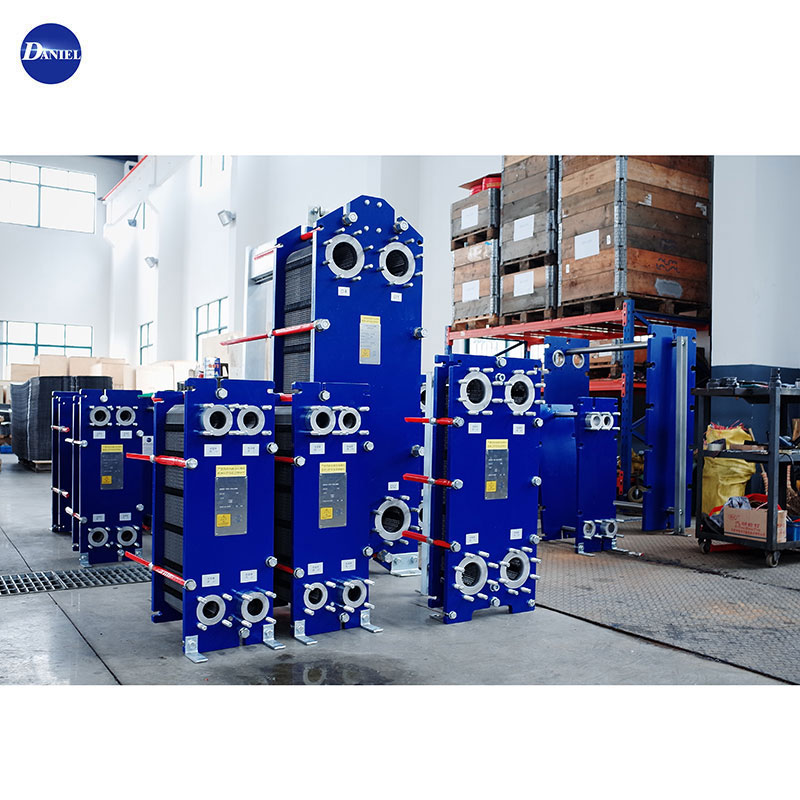
 English
English  Español
Español Português
Português русский
русский Français
Français 日本語
日本語 Deutsch
Deutsch tiếng Việt
tiếng Việt Italiano
Italiano Nederlands
Nederlands ภาษาไทย
ภาษาไทย Polski
Polski 한국어
한국어 Svenska
Svenska magyar
magyar Malay
Malay বাংলা ভাষার
বাংলা ভাষার Dansk
Dansk Suomi
Suomi हिन्दी
हिन्दी Pilipino
Pilipino Türkçe
Türkçe Gaeilge
Gaeilge العربية
العربية Indonesia
Indonesia Norsk
Norsk تمل
تمل český
český ελληνικά
ελληνικά український
український Javanese
Javanese فارسی
فارسی தமிழ்
தமிழ் తెలుగు
తెలుగు नेपाली
नेपाली Burmese
Burmese български
български ລາວ
ລາວ Latine
Latine Қазақша
Қазақша Euskal
Euskal Azərbaycan
Azərbaycan Slovenský jazyk
Slovenský jazyk Македонски
Македонски Lietuvos
Lietuvos Eesti Keel
Eesti Keel Română
Română Slovenski
Slovenski मराठी
मराठी Srpski језик
Srpski језик
Analysis and Maintenance of Common Failures of Plate Heat Exchanger
Analysis and maintenance of common failures of plate heat exchanger
In order to ensure the normal operation of the plate heat exchanger and prolong the service life of key components such as plates and rubber pads, it is particularly important to understand the failures of the plate heat exchanger and its causes and disposal methods.
1. Leakage
It means that the leakage is not large, the water droplets are discontinuous and the leakage is large. The main parts of the continuous leakage of water droplets are the seal between the plate and the plate, the leakage groove of the second seal of the plate and the end plate. And the inside of the compression plate.
Causes of leakage
①The clamping size is not in place, the size is uneven everywhere, and the size deviation should not be greater than 3mm or the clamping bolts are loose.
②Part of the gasket is out of the sealing groove, there is dirt on the main sealing surface of the gasket, the gasket is damaged or the gasket is aging.
③The plate is deformed, and the assembly misalignment causes the running pad.
④ There are cracks in the sealing groove of the plate or the second sealing area.
Maintenance method
①No pressure state, re-clamp the equipment according to the clamping size provided by the manufacturer. The size should be uniform, and the deviation of the compaction size should not exceed ±0.2Nmm. N is the total number of plates. The parallelism between the two compaction plates should be maintained at 2mm. Within.
②Make a mark on the leakage part, then disassemble the heat exchanger and investigate and solve it one by one, reassemble or replace the gasket and plate.
③Disassemble the open heat exchanger, repair the deformed parts of the plate or replace the plate. When there is no spare part for the plate, the plate at the deformed part can be temporarily removed and then reassembled for use.
④ When reassembling the disassembled plates, clean the plate surface to prevent dirt from adhering to the gasket sealing surface.
2. String liquid
It is characterized by the fact that the medium on the higher pressure side is strung into the medium on the lower pressure side, and pressure and temperature abnormalities will appear in the system. If the medium is corrosive, it may also cause corrosion of other equipment in the pipeline. Liquid leakage usually occurs in the diversion area or the secondary sealing area.
Causes of fluid leakage
① Due to improper selection of plates, cracks or perforations are caused by corrosion of plates.
②The operating conditions do not meet the design requirements.
③The residual stress after cold stamping of the plate and the clamping size during assembly are too small to cause stress corrosion.
④ There is a slight leakage in the plate leakage groove, which causes the harmful substances in the medium to concentrate and corrode the plates, forming a string of liquid.
Maintenance method
① Replace the cracked or pierced plate, and use the light transmission method to find the crack on the plate.
②Adjust the operating parameters to reach the design conditions.
③The clamping size should meet the requirements during the repair and assembly of the heat exchanger, not as small as possible.
④The plate materials are reasonably matched.
3. Large pressure drop
The pressure drop of the medium inlet and outlet exceeds the design requirements, or even many times higher than the design value, which seriously affects the system's requirements for flow and temperature. In the heating system, if the pressure drop on the hot side is too large, the primary side flow will be seriously insufficient, that is, the heat source is insufficient, resulting in the secondary side outlet temperature that cannot meet the requirements.
4. The heating temperature cannot meet the requirements
The main feature is that the inlet temperature is low, which fails to meet the design requirements.
cause
① Insufficient medium flow on the primary side causes a large temperature difference on the hot side and a small pressure drop.
②The cold side temperature is low, and the temperature at the cold and hot ends is low.
③The flow distribution of multiple plate heat exchangers operating in parallel is uneven.
④The internal scale of the heat exchanger is serious.

In order to ensure the normal operation of the plate heat exchanger and prolong the service life of key components such as plates and rubber pads, it is particularly important to understand the failures of the plate heat exchanger and its causes and disposal methods.
1. Leakage
It means that the leakage is not large, the water droplets are discontinuous and the leakage is large. The main parts of the continuous leakage of water droplets are the seal between the plate and the plate, the leakage groove of the second seal of the plate and the end plate. And the inside of the compression plate.
Causes of leakage
①The clamping size is not in place, the size is uneven everywhere, and the size deviation should not be greater than 3mm or the clamping bolts are loose.
②Part of the gasket is out of the sealing groove, there is dirt on the main sealing surface of the gasket, the gasket is damaged or the gasket is aging.
③The plate is deformed, and the assembly misalignment causes the running pad.
④ There are cracks in the sealing groove of the plate or the second sealing area.
Maintenance method
①No pressure state, re-clamp the equipment according to the clamping size provided by the manufacturer. The size should be uniform, and the deviation of the compaction size should not exceed ±0.2Nmm. N is the total number of plates. The parallelism between the two compaction plates should be maintained at 2mm. Within.
②Make a mark on the leakage part, then disassemble the heat exchanger and investigate and solve it one by one, reassemble or replace the gasket and plate.
③Disassemble the open heat exchanger, repair the deformed parts of the plate or replace the plate. When there is no spare part for the plate, the plate at the deformed part can be temporarily removed and then reassembled for use.
④ When reassembling the disassembled plates, clean the plate surface to prevent dirt from adhering to the gasket sealing surface.
2. String liquid
It is characterized by the fact that the medium on the higher pressure side is strung into the medium on the lower pressure side, and pressure and temperature abnormalities will appear in the system. If the medium is corrosive, it may also cause corrosion of other equipment in the pipeline. Liquid leakage usually occurs in the diversion area or the secondary sealing area.
Causes of fluid leakage
① Due to improper selection of plates, cracks or perforations are caused by corrosion of plates.
②The operating conditions do not meet the design requirements.
③The residual stress after cold stamping of the plate and the clamping size during assembly are too small to cause stress corrosion.
④ There is a slight leakage in the plate leakage groove, which causes the harmful substances in the medium to concentrate and corrode the plates, forming a string of liquid.
Maintenance method
① Replace the cracked or pierced plate, and use the light transmission method to find the crack on the plate.
②Adjust the operating parameters to reach the design conditions.
③The clamping size should meet the requirements during the repair and assembly of the heat exchanger, not as small as possible.
④The plate materials are reasonably matched.
3. Large pressure drop
The pressure drop of the medium inlet and outlet exceeds the design requirements, or even many times higher than the design value, which seriously affects the system's requirements for flow and temperature. In the heating system, if the pressure drop on the hot side is too large, the primary side flow will be seriously insufficient, that is, the heat source is insufficient, resulting in the secondary side outlet temperature that cannot meet the requirements.
4. The heating temperature cannot meet the requirements
The main feature is that the inlet temperature is low, which fails to meet the design requirements.
cause
① Insufficient medium flow on the primary side causes a large temperature difference on the hot side and a small pressure drop.
②The cold side temperature is low, and the temperature at the cold and hot ends is low.
③The flow distribution of multiple plate heat exchangers operating in parallel is uneven.
④The internal scale of the heat exchanger is serious.

Send Inquiry
X
We use cookies to offer you a better browsing experience, analyze site traffic and personalize content. By using this site, you agree to our use of cookies.
Privacy Policy





